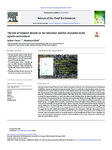The role of titanium dioxide on the behaviour and fate of plastics in the aquatic environment
| dc.contributor.author | Turner, Andrew | |
| dc.contributor.author | Filella, M | |
| dc.date.accessioned | 2023-02-24T17:37:26Z | |
| dc.date.issued | 2023-04-15 | |
| dc.identifier.issn | 0048-9697 | |
| dc.identifier.issn | 1879-1026 | |
| dc.identifier.other | 161727 | |
| dc.identifier.uri | http://hdl.handle.net/10026.1/20497 | |
| dc.description.abstract |
Although titanium dioxide (TiO2) is the most widely used pigment in plastics, there is limited quantitative information available for consumer goods and environmental samples. Moreover, and despite its photocatalytic activity, the potential impacts of TiO2 on the behaviour and fate of environmental plastics has received little attention. This paper compiles measurements of Ti in plastic samples from aquatic environments and in consumer goods that are known to make important contributions to environmental pollution. These data, along with a critical evaluation of experimental studies using TiO2-pigmented plastics, are used to formulate an understanding of how the pigment modifies the properties and persistence of environmental plastics. Titanium is heterogeneously distributed amongst different categories and sources of plastic, with concentrations ranging from <1 mg kg-1 in transparent-translucent materials to over 50,000 mg kg-1 in brightly coloured samples. Concentrations towards the higher end are sufficient to change positively buoyant polyolefins into negatively buoyant plastics, suggesting that environmental fractionation based on Ti content might occur. Accelerated leaching of TiO2 from aged plastic has been demonstrated empirically, and while mobilised particles are reported within a size range greater than biotically-active titania nanoparticles, modelling studies suggest that the latter could be derived from TiO2 pigments in the environment. Although rutile appears to be the most important polymorph of TiO2 in non-fibrous plastics, the degree and type of engineered surface modification in consumer and environmental plastics are generally unknown. Surface modification is likely to have a significant impact on the photo-oxidative degradation of plastics and the mobilisation of fine (and, possibly, nano-sized) TiO2 particles and requires further research. | |
| dc.format.extent | 161727-161727 | |
| dc.format.medium | Print-Electronic | |
| dc.language | en | |
| dc.language.iso | eng | |
| dc.publisher | Elsevier BV | |
| dc.subject | Polymers | |
| dc.subject | Additives | |
| dc.subject | Pigment | |
| dc.subject | Microplastics | |
| dc.subject | Density | |
| dc.subject | Photodegradation | |
| dc.title | The role of titanium dioxide on the behaviour and fate of plastics in the aquatic environment | |
| dc.type | journal-article | |
| dc.type | Journal Article | |
| plymouth.author-url | https://www.webofscience.com/api/gateway?GWVersion=2&SrcApp=PARTNER_APP&SrcAuth=LinksAMR&KeyUT=WOS:000935419400001&DestLinkType=FullRecord&DestApp=ALL_WOS&UsrCustomerID=11bb513d99f797142bcfeffcc58ea008 | |
| plymouth.volume | 869 | |
| plymouth.publication-status | Published | |
| plymouth.journal | Science of The Total Environment | |
| dc.identifier.doi | 10.1016/j.scitotenv.2023.161727 | |
| plymouth.organisational-group | /Plymouth | |
| plymouth.organisational-group | /Plymouth/Faculty of Science and Engineering | |
| plymouth.organisational-group | /Plymouth/Faculty of Science and Engineering/School of Geography, Earth and Environmental Sciences | |
| plymouth.organisational-group | /Plymouth/REF 2021 Researchers by UoA | |
| plymouth.organisational-group | /Plymouth/REF 2021 Researchers by UoA/UoA07 Earth Systems and Environmental Sciences | |
| plymouth.organisational-group | /Plymouth/Research Groups | |
| plymouth.organisational-group | /Plymouth/Research Groups/BEACh | |
| plymouth.organisational-group | /Plymouth/Research Groups/Marine Institute | |
| plymouth.organisational-group | /Plymouth/Users by role | |
| plymouth.organisational-group | /Plymouth/Users by role/Academics | |
| dc.publisher.place | Netherlands | |
| dcterms.dateAccepted | 2023-01-16 | |
| dc.rights.embargodate | 2023-2-28 | |
| dc.identifier.eissn | 1879-1026 | |
| dc.rights.embargoperiod | Not known | |
| rioxxterms.versionofrecord | 10.1016/j.scitotenv.2023.161727 | |
| rioxxterms.licenseref.uri | http://www.rioxx.net/licenses/all-rights-reserved | |
| rioxxterms.licenseref.startdate | 2023-01-23 | |
| rioxxterms.type | Journal Article/Review |


